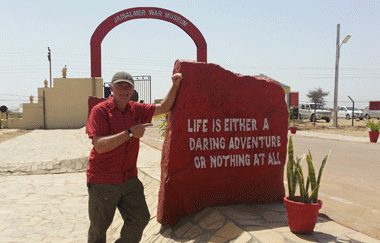
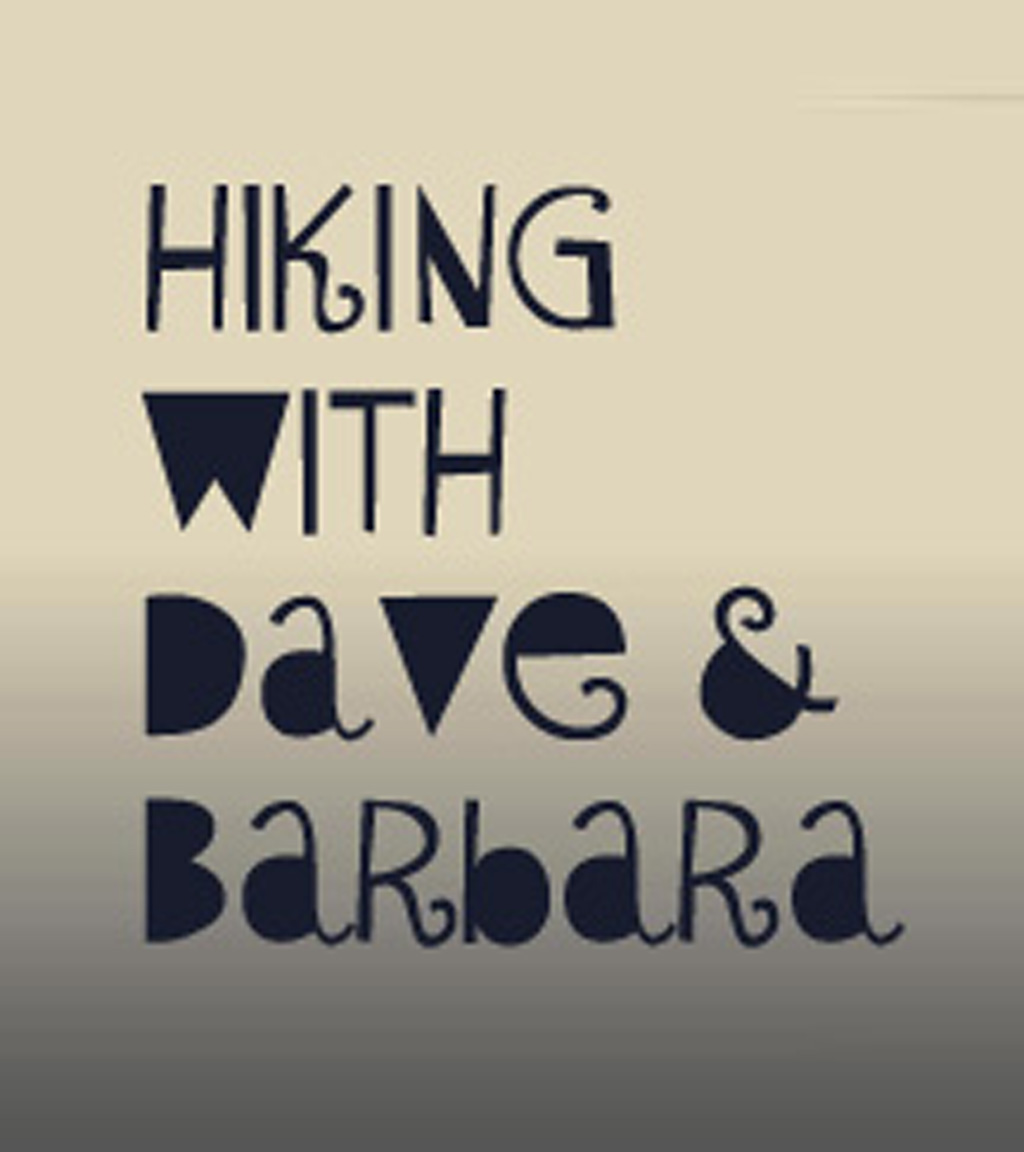

This Dave & Barbara special, shows how easy it is to take a self arranged and self guided trip to see some of Northern Spains best villages, mountains and beaches located in and around the stunning Picos de Europa national park.
Journey From Manchester to Santander
We had decided a few weeks earlier having checked the weather forecast, that we would like to return to probably our favourite country - Spain. If people have not been to this wonderful country, it has beautiful walking in incredible national parks, good priced food and accommodation, big empty roads-the majority are toll free-and fantastic scenery. It is a Country we have visited many times over the last 25 years, visiting the many historic cities, Roman ruins, walking 2 different Caminos, and there is always a beach. The people are friendly, speak English on the Costas, and we have learnt some Spanish over the years which is always useful.
Usually we have flown, or driven through France. On this occasion we decided to take the easy option and booked with Brittany Ferries from Plymouth to Santander. An overnight trip of 24 hours with a cabin. We have taken this trip once before-on board there are restaurants, duty free shop, bars with televisions showing sports, entertainment, cinema etc.
Leaving home in Manchester at 9am, it was an easy 5 and a half hour journey to Plymouth, with a stop en-route. Arriving in Plymouth we visited a small Tesco in the town, alternatively there is a large Sainsbury's on the way in.
The ferry left at 7pm, one hour late due to storms on its way over, but it made up the time. We had been in Tesco and purchased cold food which we enjoyed eating whilst sitting on deck chairs overlooking the sea with England fading into the distance. Just to start the trip to Spain we had brought with us our favourite bottle of Rioja together with plastic glasses. We took the remains of the bottle inside and drank it whilst watching the England football game and watched a singer perform, before retiring to our inside cabin with an en-suite bathroom.
The glorious thing about a 24 hour ferry is that this is one of the few occasions in your life when there is no need to get up in the morning. We collected a coffee from a machine and drank it in our cabin with brioche purchased previously from Tesco. We saw "Yesterday" the movie at the small cinema at 12pm. A good way to pass the time, great value for only £6.50, and we were surprised to find there were not more people watching it. There are 3 restaurants onboard with lots of choices, at varying reasonable prices. We ate a late lunch of caesar salad costing £5.00.
Previously we have driven to Dover, caught the boat to Calais, then driven down through France to Spain. The ferry is a good alternative, maybe more expensive than driving(but the ferry price can depend on how far in advance you book), but so
much more relaxing and arrive feeling refreshed. But if not driving through France, savings are made in terms of not paying for an overnight hotel, petrol, road tolls and less wear and tear on the car. We had driven home the previous year from Spain through France and suffered many road closures and road blocks caused by the yellow jackets strike. Eventually after much disruption, closed motorways, and long queues, being stopped at nighttime to ask where we were going, we managed to catch the 4am ferry from Dieppe to Newhaven, instead of the Calais to Dover ferry at 8pm as we had hoped. This did put us off driving through France again.
It was a lovely crossing, the Ferry was very nice and clean, we had an inside cabin with bunk beds and an en-suite bathroom . Entertainment on board and as I say three restaurants, however you can take all your own food and drink on board. We were looking forward to landing and driving to our destination for the next 6 nights Arenas de Cabrales, having booked the hotel 2 days before the trip.
Santander to Arenas de Cabrales, Picos de Europa
The boat docked in Santander on time with everyone off the Ferry by 6pm. Our first stop slightly off the route was Aldi in Torrelavega, knowing from previous experience once inside the Picos National Park the food would be more expensive. We checked into our destination, The Hotel La Rivera, Arenas de Cabrales at 7.30pm, parking outside to drop off our luggage prior to parking on the free car park nearby. We chilled in our room watching news of terrible floods in other parts of Spain, eating salad, fruit and bread from Aldi looking forward to the next day.
Day 1 - Cares Gorge, Picos de Europa, Northern Spain
Cares Gorge or La Garganta Del Cares is located in the Picos de Europa Mountains in Northern Spain. We had visited this area about 7 years ago, and enjoyed fabulous scenery and great walking so had decided to return. We would recommend this area, not only due to the scenery, but also good value for money accommodation and food, empty roads, friendly locals, and well signposted paths.
On the first day of our trip we chose complete an iconic walk. The walk is a linear 12km walk to the beautiful village of Cain. I would advise people who are scared of heights not to do this walk, as at times there are vertical drops to the river far below. A canal carrying water for hydro electric power was built in1916 typical of many water channels in Spain. A service path for the canal was built alongside in 1940, which is now used by tourists. Take plenty of water and food as none are available along the path, and sturdy footwear and mind the edge, as well as potential rock falls. During the months of November to May there may be snow or ice, making it very dangerous.
The hotel La Rivera Arenas de Cabrales where we stayed served breakfast from 8.30am, but having decided to leave earlier than this, we went to Cares Cafe over the road from the hotel. After having coffee and toast €2.80 each we left. Arenas is a convenient location for the walk, being only 4km from the start. It was a beautiful drive with the mist clearing from the valley, and bright sunshine appearing over the mountains. We parked in a lay-by at Puente Poncebos at the side of the road by the Los Picos sign, and walked through a tunnel. To the left over the bridge is a medium sized car park which was filling up fast, the track leading to the start was lined with cars. This was a week day in September, it is reputed to be extremely busy in July and August and at weekends. We previously visited in mid October when there were only 3 cars parked. Parking is free, as is entry to the gorge.

We followed the road past the Hotel Mirador, arriving at the well marked start at 9.15am, with a useful information board and a map and any current problems are also posted so worth a look, signed Cain 3 hours. All the way to Cain the path is very obvious. Initially it gradually rises and passes an interesting ruined farm on the left, with fantastic views of the valley. After 250m of climbing we reached the highest point of the walk at Los Collados at 10.05am. Plenty of people were also walking.
The path continues keeping to the right hand side of the gorge. Be careful not to lose your footing as the path is not wide, and in places there is a very steep drop to the River Cares below. In places it is carved out, with massive overhangs of rock above your head. A small section of the path was replaced in 2013, and now consists of wood, with a corrugated iron panel in, so you can gaze down if brave enough at the river far far below.
At 12.15pm we went over the first of a couple of bridges - Puente Bolin- before the path eventually returns to the right hand side. At this point there is a long walk through a tunnel, with a couple of windows in, but taking a torch is advisable as it is dark, with plenty of puddles and low ceilings. Take care not to bang your head.
After a leisurely walk admiring the views, taking photos and chatting to fellow walkers, we arrived in Cain at 12.45pm, We ate our sandwiches on a grassy bank by the river. Then had coffee and a pint of lager (€5.40) with free Bombay Mix in the Albergue, which had free WIFI connection, no data being available in the gorge.
Cain is a lovely small village in an exquisite location surrounded by high mountains some with patches of snow on the tops. There are about 5 bars/ restaurants, a couple of hotels, souvenir shops and a couple of food shops. Menu of the day is available at €12 for 3 courses, sandwiches are €4/5. It is well worth a visit in its own right
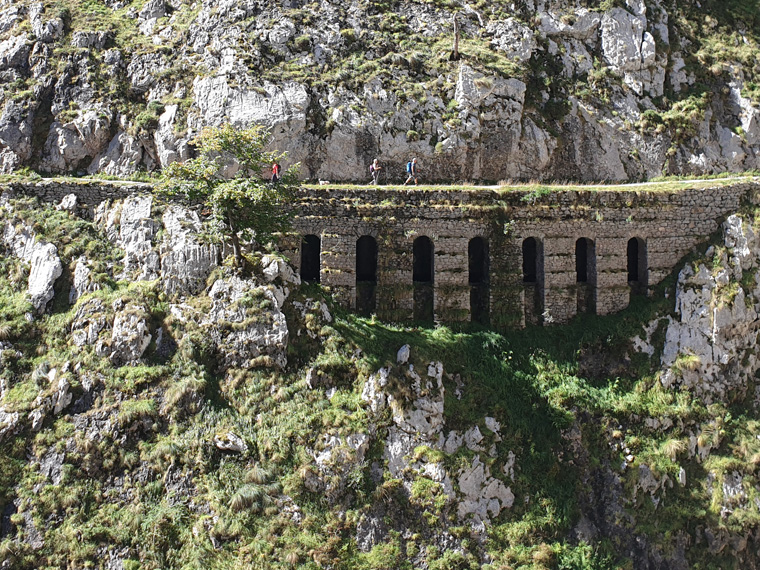
We eventually reluctantly left Cain at about 2.15pm, wishing to sit out in the sunshine for longer, but realising it is at least 3 hours back to the car. It seemed to get hotter and hotter as the afternoon progressed, with plenty of walkers heading in both directions. Towards the end of the gorge the path rises and falls again, before we eventually returned to the car at 5.40pm, for the short drive back to our hotel
This was a simply stunning walk with fantastic limestone scenery, complete with vultures flying overhead. Both sides of the gorge rise to100s of feet above the River Cares, I would definitely recommend this walk, except if you have a fear of heights. Even then the first hour could still be attempted to reach sublime views down the gorge. Note that there are no facilities after leaving the Hotel Mirador until reaching Cain at least 3 hours later.
Distance 14 miles (22.5km)
Duration of Walk Hours 8.05
Average Pace Min/Mile 30.35
Steps 463761
Elevation gained 2900feet (883m)
Information/Advice
Be aware vertiginous drops, so complete the walk if you are not scared of heights, and mind children/pets carefully.
Don't attempt in snowy/icy weather, one false slip and you could be over the edge.
Take plenty of water, food, sun hats, sun screen, torch for the tunnels, wear walking shoes/boots and mind your step.
If only wishing to walk one way, apparently there is a taxi, €145 from Cain covering the 125 km to Arenas or late in the afternoon there is a bus. Alternatively a better idea would be just to walk half way down the gorge before turning round.
Parking is probably an issue during the summer months and at weekends, so arrive early to get a space.
This area of Northern Spain is accessible from England either by driving through France, or flying to Bilbao, then hiring a car or the route that we took, driving from our home in Manchester then catching the 24 hour relaxing ferry from Plymouth to Santander. From there we visited Aldi in Torrelavega as the food is more expensive in the Picos national park area, and drove to where we were staying in La Rivera Arenas de Cabrales for 5 days.
Resources Used
Picos De Europa car tours and walks, by Teresa Farino Sunflower Press
Picos de Europa Map scale 1:80.000
Spanish Trails, Book 1, Los Picos De Europa by Phil Lawler, was recommended by fellow walkers.
Another book is Picos de Europa et sur la cote Cantabrique, by Alban Boyer. This is in French, but with maps in and accurate timings, you could get the gist even without knowledge of the language.
Websites used
/https://la-rivera-es.book.direct/en-gb
https://www.brittany-ferries.co.uk/
Day 2 - Naranjo de Bulnes, Urriellu, Picos de Europa, Northern Spain
Today we decided to walk from the village of Sotres to the refuge at Delgada Ubeda, basing it on a walk we had seen in the book "In the Picos de Europa by Vicente Ena Alvarez, and a Picos map. This allows us to walk to the base of one of the most magnificent peaks in the Picos, Naranjo de Bulnes, which stands at 2519m. The top is only accessible by rock climbing. It is called the orange mountain due to the colours cast on the limestone at sunset. This is a lovely walk which enables you to get into the heart of the Picos, and gaze in awe at one of the most iconic mountains.
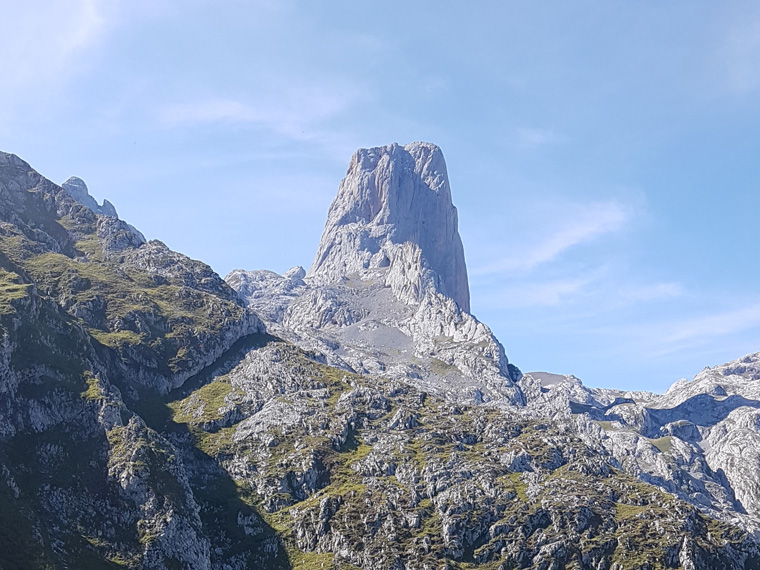
The hotel La Rivera Arenas de Cabrales where were staying served breakfast from 8.30am, but having decided to leave earlier than this we went to Santelmo cafe, Arenas de Cabrales, coffee and toast €6 for 2. Then a 30 minute beautiful drive passing through tunnels via Panes(full services) brought us to the mountain village of Sotres. Parking at 9.10am in the already busy car park, we searched in vain for the start of our walk
We walked back through the village and down the road we had just driven up, for 20 minutes. Then on a corner is a left turn signed for Urriellu, where parking is available on the road. Frustrating, but hey ho. We continued along a track turning right at another sign and descended through a beautiful empty settlement. We could only presume that the buildings here are used to house cattle during the cold winter months. We continued over the river and up the rough road, wondering why so many cars were coming past us.
Eventually at 10.55am we came to the end of the road. Now it became apparent why there are so many cars, as there was a big parking area. Checking a Spanish walking book later, this was given as the start of the walk. In our book the start was in Sotres!! I would recommend parking here, but at the same time given the condition of the road, I may be concerned about driving up it. Frustratingly we definitely could have parked a lot nearer to the start of the walk, given the heat this would have been a good idea.
From the parking area at 1100m go up the grassy slope, then follow the sign saying Refugio Vega Urriellu 2 hours 40 min. We thought this a bit of a long time, as we had already been walking for nearly 2 hours.
The real walk now begins surrounded by beautiful countryside, scree slopes, huge mountains with vultures and alpine choughs- which are quite unique with yellow beaks, and orange legs, soaring over head. Take the left hand turn. We reached the Refuge Terenosa at 11.30am, but we continued past as we needed to get going. The well marked trail which keeps to the left hand side of the valley has some steep drops to the right and is easy to follow. Rounding the corner, we had the first stunning views of the mountain, which we found to be better from a distance than up close. We got overtaken by 3 donkeys and their owners, who were taking supplies to Refugio Delgado Ubeda.

We happily arrived at the top refuge 1953m at 2pm, quickly eating our lunch, realising it was a long way back to the car. It is possible to stay in the refuge as many on the path were doing, a lot carrying ropes in order to summit Naranja, the only way possible is by rock climbing. We left here at 2.15pm, by 2.45pm back amongst the boulders, 3.40pm through the gap in the rock. It was hot, somewhere in the high 20s, with little shade, and the sun bouncing off the rocks. The donkeys on their downwards journey overtook us once more.
On this occasion we stopped at the Terenosa refuge at 4.15pm for coffee, coke, and chocolate, you could stay the night here. We looked at the very cramped mattresses together with the lack of bathroom facilities and decided it would not be for us! Ten minutes later we were back at the signpost and a lovely view to Sotres where our car was parked, looking far away on the other side of a valley. By 5pm back in the turning circle and at 6pm back on main road. We walked steeply uphill back through the village to the car park at 6.15pm. A 9 hour day, but could have been reduced if parking further down the road, which I would heartily recommend
We ate dinner in Santelmo restaurant in Arenas de Cabrales, the service was slow, poor overcooked chicken, pork so thin it was barely on the plate, together with chips, lettuce, tomato and onion. Obviously we should have just stuck to eating breakfast there.
Distance 14.05miles (22.05km)
Duration of Walk Hours 8.45
Average Pace Min/Mile 37.17
Steps 47913
Elevation gained 47431feet (1440m)
Information/Advice
Take plenty of water, food, sun hats, sun screen, wear walking shoes/boots and mind your step.
If parking in the official car park in Sotres, remember that this will add about 90 minutes each way to the walk. It is possible to park on the road which leads to or at the end of the road is a parking area.
This area of Northern Spain is accessible from England either by driving through France, or flying to Bilbao, then hiring a car or the route that we took, driving from our home in Manchester then catching the 24 hour relaxing ferry from Plymouth to Santander. From there we visited Aldi in Torrelavega as the food is more expensive in the Picos national park area, and drove to where we were staying in La Rivera Arenas de Cabrales for 5 days.
Resources used
In the Picos de Europa-a slightly strangely written book, by Vicente Ena Alvarez.
Map Picos de Europa topographic map, with 50 hiking trails, scale 1:80,000.
On this walk we met the only English couple of the trip who were staying in Sotres and going out for walks from there each day, sometimes catching a taxi to the start. Maybe a plan for another time. They recommended a book Spanish Trails, Book 1, Los Picos De Europa by Phil Lawler. They had parked at the top of the track, relieving themselves of the additional many hours that we had walked. Obviously this is the book we needed to buy.
Another book is Picos de Europa et sur la cote Cantabrique, by Alban Boyer. This is in French, but with maps in and accurate timings, you could get the gist even without knowledge of the language.
Websites
https://la-rivera-es.book.direct/en-gb
https://restaurantesantelmo.es/
https://www.brittany-ferries.co.uk/
Day 3 - Treviso, Picos de Europa, Northern Spain
The remote mountain village of Treviso until a few years ago was accessible only by a path built by engineers in the19th century to access the mines. The maximum gradient is 30°for the ox-carts pulling ore downhill. The villagers used to roll the cheese down the hill every Monday to market and the postman walked the 825m uphill to arrive with the letters. These days the village has been connected to Sotres by road. However it remains a stunning walk with stupendous views and in parts a vertiginous path - not for the faint hearted. We had walked this on our previous Picos visit so knew what to expect.
We were holidaying in the Picos area of Northern Spain, staying at The Hotel La Rivera, Arenas de Cabrales. Unfortunately for us breakfast was served from 8.30am, but having decided to leave earlier than this, once again missed the breakfast and we went to Santelmo cafe, down the road, for coffee and toast €6 for 2. It is a 45 minute drive to the start of today's walk at Urdon. Taking the main road to Panes, we made a quick stop at the small Coviran supermarket. This is a small town with lots of hardware shops, tourist shops, restaurants and bars. Continuing along the main road towards Potes, we parked at Urdon, which is 2 km north of La Hermida. Parking is limited, so try to arrive early, there is a small car park with a useful map of the walk on the right hand side of the road, or parking is found in lay-bys on both sides of the road. Alternatively park in La Hermida and walk along a path just above the road which joins the walk in Urdon.
We parked at the side of the road at 9.45am with 20 other cars already there. Leaving the car park by the pretty river valley, up past the side of the power station, the route then follows the first of a series of zig zags. We passed through a closed gate on the path at 10.30am, rounding the corner at 10.45 with great views up the valley. This point is the first of many steep drops, be careful not to trip!!!
The zig zag path is easy to follow, just the heat and incline making it hard work. As it got hotter and steeper, we and others stopped to rest under the shade of the occasional tree found along the way. The fellow walkers were all friendly, a lot were accompanied by sure footed dogs.
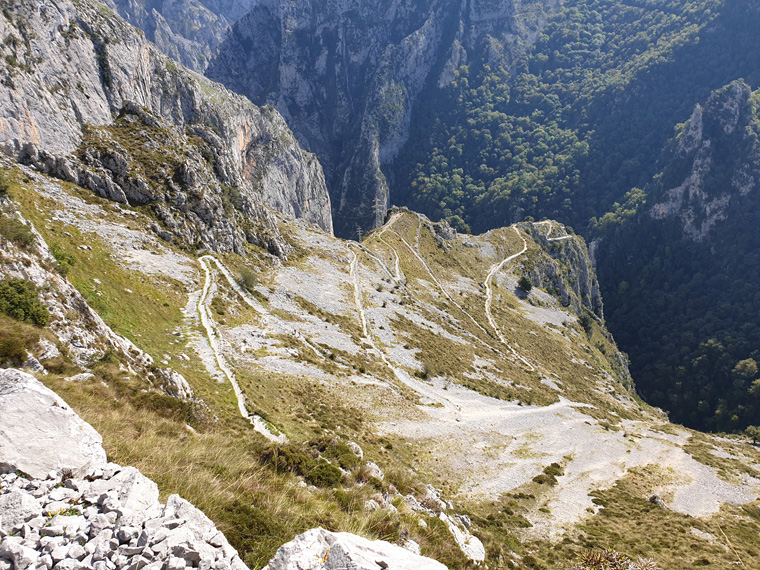
We stopped a lot to take in the brilliant views down the valley, imagining what the path looks like from the other side of the valley. Looking down on the path, it does look very steep. By 12pm we reached the top row of pylons, and the view back to the zig zags vanish. A flatter path then starts with pylons on right, followed by the 3rd set of zig zags up to the village.
Watch out for the vultures living on cliffs, we stood for a while to watch their great aeronautical displays, which they seemed to be doing just for our benefit. There is a spring by a disused building if desperate for water. At 12.30pm we reached the village path with a gloriously placed picnic bench, with views to the village and down the valley.
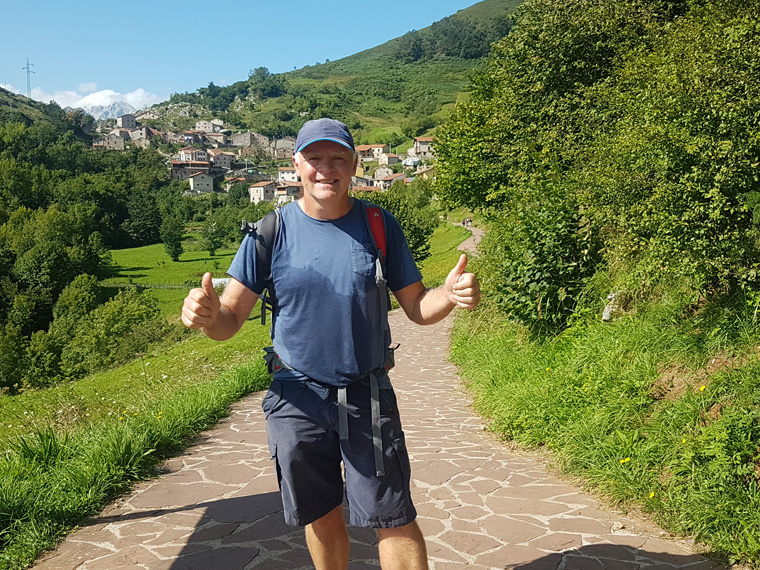
The village itself is very pretty, most houses seem to have undergone a recent make over. Most walkers appear to make for the only bar where there is seating inside and out and a restaurant. Food is sold, as well as their very famous local cheeses. We arrived at the bar at 12.35 pm, the walk taking us nearly 3 hours, but with plenty of rests. We ordered a small beer, coke and coffee costing €5.50. We took the opportunity to rest in the shade, and chat to fellow walkers. We had as usual taken our own picnic, very conveniently there are lots of picnic benches by the church in the shade, which were all empty.
The only route back to the car is to take the same path. But it is certainly a lot easier descending with great views all the way, and again accompanied by vultures, and the occasional eagle. It took us one hour to reach the view point with pylons, back at the gate on the path at 3pm and arrived back at the car at 3.40pm.
At the parking area there are no facilities, but if you fancied refreshments, drive, or walk the 2km to La Hermida. This is a pretty village with parking and lots of pretty restaurants.
Previously we undertook this walk on a mid-week October day. On that occasion we were the only car parked, the only people saw were engineers fixing the pylons along the path, and we were the only people in the village bar. On this occasion there were a lot more people, which added to the day.
Distance 9.6 miles (15.5km)
Duration of Walk Hours 6.06
Average Pace Min/Mile 38.05
Steps 33336
Elevation gained 3444feet (1049m)
Information/Advice
As usual we wore boots, took sun hats, sun tan lotion, food and plenty of water.
I would recommend this walk if you not afraid of heights. Start out early to avoid the heat of the day, there is little shade and not an abundance of parking. The walk of 1049m, 15.5 km, took us nearly 3 hours, but we were taking it easy, enjoying the views and had a drink and lunch in the village. I found it fascinating walking a historic path, imagining the carts and villagers using it before the road arrived.
Be aware of vertiginous drops at points, so complete the walk if you are not scared of heights, and mind children/pets carefully.
Don't attempt in snowy/icy weather, one false slip and you could be over the edge.
Parking is probably an issue during the summer months and at weekends, so arrive early to get a space.
This area of Northern Spain is accessible from England either by driving through France, or flying to Bilbao, then hiring a car or the route that we took, driving from our home in Manchester then catching the 24 hour relaxing ferry from Plymouth to Santander. From Santander we visited Aldi in Torrelavega as the food is more expensive in the Picos national park area, and drove to where we were staying in La Rivera Arenas de Cabrales for 5 days.
Resources/ Used
Picos De Europa car tours and walks, by Teresa Farino Sunflower Press
Picos de Europa Map scale 1:80.000
Spanish Trails, Book 1, Los Picos De Europa by Phil Lawler, was recommended by fellow walkers.
Another book is Picos de Europa et sur la cote Cantabrique, by Alban Boyer. This is in French, but with maps in and accurate timings, you could get the gist even without knowledge of the language.
Websites
https://www.mapmywalk.com/
https://www.bbc.co.uk/weather
https://la-rivera-es.book.direct/en-gb
https://www.brittany-ferries.co.uk/
Day 4 - Colombres to Llanes, Camino Norte, Northern Spain
Today we decided to do something different and not choose the Picos de Europa for a walk. A couple of years ago we walked the Camino Norte for 500 miles from its start in Irun near the French border, to Santiago de Compostela. We had enjoyed this walk so much that we decided to do one of the stages again from Colombres to Llanes. The only problem with doing a linear walk, is the ability to return to the start. There are more interesting sections of the Camino in the vicinity-more to come later-but this section has the easiest transport links, especially on a Sunday when we walked. We were very excited to see what had changed and how much of the walk we could remember. The route is usually easy to follow with yellow arrows and shells to show the way to Santiago, on the whole making a guide book unnecessary.
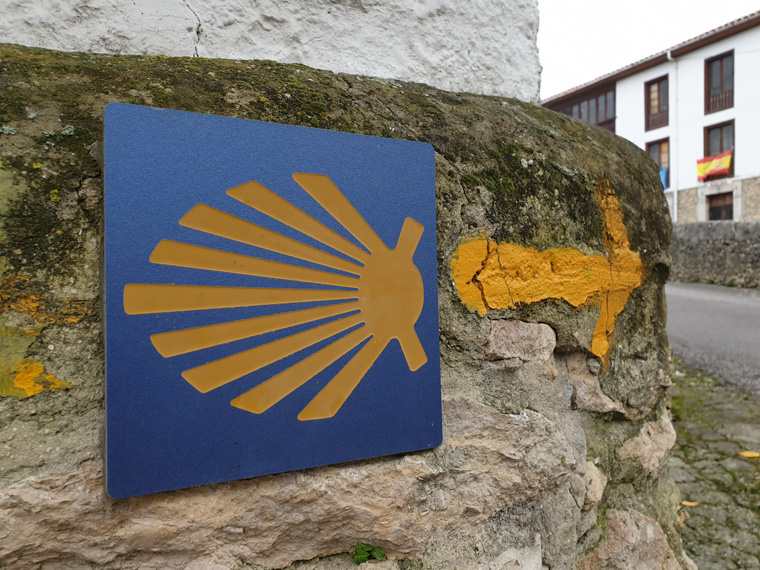
We were holidaying in the Picos area of Northern Spain, staying at The Hotel La Rivera, Arenas de Cabrales. Unfortunately for us breakfast was served from 8.30am, but having decided to leave earlier than this, once again missed the breakfast leaving the hotel at 7.40am. We drove through Panes following the River Cares shrouded in mist, very atmospheric, with an early morning mist rising over the mountains. Arriving in Colombres at 8.30am, there was plenty of free parking by the church in the middle of town. We saw about ten pilgrims all following the yellow signs to Santiago, with their huge packs on. Unfortunately there was no sign of a cafe being open, maybe due to it being Sunday.
We started walking at 8.50am, the path is easy to follow through the town, leading down through a field, then the path splits briefly, we took the left hand route past the old hermitage. We stopped at 9.10am at Hotel Restaurante Casa Junco. Coffee and toast at the usual Camino price of €2.50 each, with pilgrims eating there too.
Over the motorway, past Colombres station, left down a farm track through the very pretty town of La Franca. We continued on through woods, then walked on the bike path along the side of the main road (N-634) with sea views. The interesting village of Buelna is found to the right and is well worth the 5 minute detour to look round it. Continuing to the Albergue de Peregrinos Santa Marina and restaurant opposite could make an interesting stop, or at any point you could turn round back to Colombres, or catch the train back. Turning right off the main road we reached the Bar Castiellu, in Pendueles where we have stayed previously. We ate a Spanish speciality of tuna empanada €2 with coffee €1.30. This is a nice bar. To stay here it is €30 for a double room, €10 for a 3 course pilgrims' meal, and €1.50 for all the laundry. This is the usual price on the Camino in Spain, making it a relatively cheap holiday.
Leaving at 11.40am, it was a lovely walk across the fields down to the beach at La Paz, spending the time talking with a couple from Perth who were roughly halfway through their 4 week walk to Santiago. This is a lovely thing about walking a Camino, as one meets people from all over the world, going the same way, with the same objective in mind. So many new friends to make.
From the beach the path turns left then right, then the older route goes under a motorway and carries on further from the sea. We continued along the alternative path nearer the sea, turning right at the sign post for Bufones de Arenillas. Arriving at 12.55pm no water was in the blow hole as the tide was out, but at high tide or on a stormy day it would be spectacular. We continued on through beautiful Eucalyptus trees, over a small bridge arriving in the village of Andrin at 1.45pm. Both of us instantly recognised this as the place on the previous walk where we sheltered under the church roof from the storm, both cafes had been closed, and we had been joined by a fellow walker from Extremadura. On this occasion the weather was beautiful, both cafes were open and we ate our sandwiches by the old wash area. Following the road up hill, we joined the main road at 2.15pm.
From the view point there are fantastic views over the ocean with the lovely smell of Eucalyptus trees. Here there is a choice, to go down the road, and eventually through Cue to Llanes. But we chose the more scenic route, which follows a long path along the side of the golf course with views over to the sea and our destination of Llanes in the distance. Passing an old Hermitage, then a new aubergue, we followed the arrows into town arriving in Llanes harbour at 3.30pm. Strangely neither of us could remember this path or Llanes. We then realised last time the weather had been so bad, that from the viewpoint we had walked straight down the road and visited a cafe on the bridge near the harbour, absolutely soaked. Fortunately the weather was much better on this occasion. The Camino is increasing in popularity with more cafes and accommodation springing up along its route. We definitely saw more pilgrims than 2 years ago.
Llanes is a pretty destination in itself, with plenty of people out for a late lunch. We had a coffee in the main square, on the other side of the river at 4pm, then walked the 500m to the bus station. The cafe and ticket office were shut, probably as it was Sunday. On the platform is a ticket machine which takes card and cash up to €10, then issues tickets. It is €2 each on the bus back to Colombres, which leaves at 4.55pm otherwise the train is at 6.30pm. The advantage of the bus is that it goes into Colombres itself, rather than the train station which is about 1km out of town, near where we had eaten breakfast. Various buses kept arriving and departing with some confusion over their destination as nothing was written on the front. Our bus arrived at 5.10pm, but we were pleased that we had the train or a taxi as a backup plan, returning to Colombres at 6pm.
We had seen adverts for a 3 day fiesta in the town of Carrena a couple of miles down the road from where we were staying, so decided to visit on our way back to the hotel. It was busy when we arrived, parking up we walked into the village. There was a bar, a main centre stage with seats and bands of up to 10 people playing a simple type of bagpipe, and dancing. Many people were dressed in the local costumes. This was lovely to see, and definitely worth a small detour.
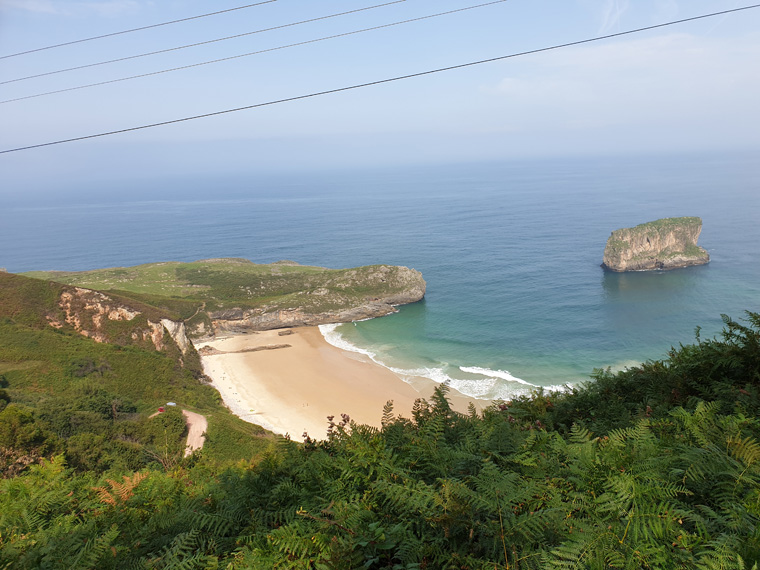
We ate dinner back in Arenas in the Restaurant de Cares, a delicious 3 course dinner with wine €15. We ate water melon and goats cheese salad, cod pancake in pepper sauce and apple pie. Delicious and to be recommended.
We were really pleased that we had spent the day on this walk. Many more pilgrims were walking than we did it 2 years ago. Other stages of the Camino Norte can be followed, maybe some are more interesting than this stage i.e. Santillana to Comillas, or Llanes to Ribadesella . But we chose this stage as it is relatively near to where we were staying in Arenas, and more importantly as it was a linear walk, we able to catch the bus back. Alternatively there is a train that runs along the coast line. Both timetables are available on line.
Distance 14.5 miles (23.3km)
Duration of Walk Hours 7
Average Pace Min/Mile 26
Steps 36,000
Elevation gained 1002 feet (300m)
Information/Advice
As usual we wore boots, took sun hats, sun tan lotion, food and plenty of water.
Having walked just one stage of the Camino, we realised how much we had enjoyed walking the Camino Norte, and the Camino de Santiago previously. The sense of everyone walking the same way, many new friends to meet from all over the world, well signposted and unplanned walking, and a great sense of achievement when it ends. It is mindfulness at its best, and definitely something to recommend even if all of the walk cannot be completed in one trip.
We really enjoyed the Fiesta we visited. If in the area it would be worth checking them out.
This area of Northern Spain is accessible from England either by driving through France, or flying to Bilbao then hiring a car or the route that we took, driving from our home in Manchester then catching the 24 hour relaxing ferry from Plymouth to Santander. From Santander we visited Aldi in Torrelavega as the food is more expensive in the Picos national park area, and drove to where we were staying in La Rivera Arenas de Cabrales for 5 days.
Resources/ Used
Book -The Northern Caminos by Laura Perazzoli and Dave Whitson Cicerone press, given as stage 15
Websites
https://la-rivera-es.book.direct/en-gb
https://www.pilgrim.es/en/northern-way/stage-16-colombres-llanes/
https://www.brittany-ferries.co.uk/
alsa.es
Day 5 - Covadonga, Lakes De La Ercina, and Belbin Picos de Europa,
Visiting the lakes area of the Eastern Picos is recommended online, and is an area we had not previously visited. We were looking forward to seeing the 2 glacial lakes, limestone pavements, alpine flora and the apparently magnificent view from the Vega de Ario. However, things don't always go as planned.
We were holidaying in the Picos area of Northern Spain, staying at The Hotel La Rivera, Arenas de Cabrales. Unfortunately for us breakfast was served from 8.30am, but having decided to leave earlier than this we went to Santelmo cafe, just down the road, having coffee and toast €6 for 2. It is a 30 minute drive to the start of today's walk at Covadonga near Cangas De Onis. We were following a walk given in the Sunflower guide to the Picos, and planned to drive up to the Lakes and park as described in the book.
We arrived at 8.45am to find out that after 8.30am it is no longer possible to drive to the lakes. Since our book was published, in order to reduce the car pollution within the area many large car parks have been built, and a bus service provided to the Lakes. We parked in the final car park at the top of the valley, just before the barrier, to enable us to visit the town of Covadonga later. Parking is free, but the bus fare is €9 return adult, €3.5 child, the first bus being at 9.30am, last one down is at 7.30pm, but the times do alter throughout the year. In Ordesa National park in the Pyrenees, there is a similar scheme, but the bus is €4.50 return and runs more frequently.
The bus is large and was about half full, this was a quiet mid-week in September, again get there early if wishing to travel. Two dogs per trip can be taken in the luggage area underneath the bus. If you have booked into the Refuge it is permitted to drive through the barrier and park at the Lake at any time of day.
The bus left at 9.30am and followed the steep windy road for 12km with excellent views to mountains in the distance. We arrived at the top car park at 9.50am,with free toilets, and a kiosk giving out maps of the lakes. The visitor centre and shop open at 10am.

We struggled to find the start of the path, as the bus does not actually go to the Lake itself. If you don't want to walk to the lake, there is a small bus to take which costs €1. We walked past the closed visitor centre, along a road, then on the right spotted the sign to Belbin, where we went later. Our path goes near the east shore of Lago de La Ercina, past some cow sheds on the left, then away from the lake. At this point, we were at least an hour later than we had expected to be.
Beautiful alpine limestone scenery, meadows and gorse heath are now reached with only cows for company, having left the crowds behind by the Lakes. It is all very pretty, cows with bells, hens running around amongst them, with some scattered shepherds' huts. A cacophony of noise.
We reached a sign post to Vega de Ario and los Lagos at 11.45am, eating our lunch just near a dried-up lake. In the guide book it is about one hour from the car park by the lake to here. It had taken us over 3 hours from where we had parked near Covadonga. From here it is a further 2 to 3 hours to the Refugio de Ario, which was our original destination. However, due to time constraints we had to can that idea, and we took a path down a different valley to the one that we had come up, towards Belbin. If wishing to go to the Refuge turn right up the hill.
The path down is mostly easy to follow, (except in bad weather) along the left hand side of the small valley, past cows and further shepherds' cottages with views towards the mountains to the northeast and back towards the mountains behind. After 45 minutes, we cut down off the ridge we were on and walked all round the seemingly deserted village of Belbin - no facilities. Sheep and cows graze here peacefully, their milk being made into local cheeses. This could be made into a film set from the middle ages, as it is so beautiful. We followed the dirt road from here that leads back towards the lakes and visitor centre.
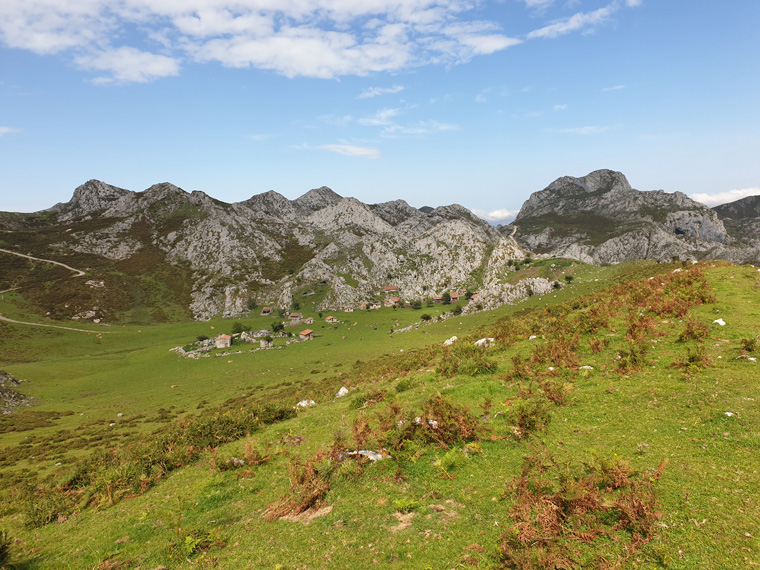
If you wanted a short walk, just walk to this village from the car park - it is well worth it. We continued along the road arriving at the visitor centre at 1.45pm. Within it is a very interesting reconstruction of The Picos, a museum, free toilets, and no cafe. We assumed the cafe is somewhere near the lakes, but did not actually go there.
We walked the ten minutes back to the car park to wait in an orderly queue under cover (fortunately as it was 26°) for the bus back down to Covadonga. At 2.30pm the bus arrived, we got on, many did not, and would have to wait another 30 minutes for the next bus- another reason to curtail this walk early. We reached the car at 3pm.
Having parked near the village of Covadonga, we went to visit. Alternatively you could get off the bus here, look at the village, then catch another bus down the valley-if you could get on. The car parks are spaced out over a few miles along the valley. Covadonga is definitely worth a visit if in the area. It possesses a church within a cave, waterfall, a huge Cathedral with free entry, a museum, tombs, and a couple of cafes. All within a stunning location.
Distance 6.98 miles (15.7km)
Duration of Walk Hours 4.10
Average Pace Min/Mile 35.55
Steps 23196
Elevation gained 1557feet (474m)
Information/Advice
As usual we wore boots, took sun hats, sun tan lotion, food and plenty of water. A compass and a whistle would be useful in bad weather.
I am not sure if I would recommend this walk at all, even though it was beautiful. I realise the reasons why a bus has been introduced, but feel that the time and money spent waiting for it was not worth it. There are many other fantastic walks in the area that could be completed instead.
If we were to do this walk again, I would definitely arrive early enough to be able to drive up to the lakes, and start walking early. We felt that this was the only way that the walk from the lakes to Refugio de Ario could be completed in a day whilst allowing yourself enough time to enjoy it.
The lakes are at 1134m and it would be easy to get lost especially in foggy weather.
A smaller walk can be done around the lakes of about 5 miles taking 2.5 hours.
This area of Northern Spain is accessible from England either by driving through France, or flying to Bilbao, then hiring a car or the route that we took, driving from our home in Manchester then catching the 24 hour relaxing ferry from Plymouth to Santander. From Santander we visited Aldi in Torrelavega as the food is more expensive in the Picos national park area, and drove to where we were staying in La Rivera Arenas de Cabrales for 5 days.
Resources Used
Picos de Europa car tours and walking guide, by Teresa Farino, Sunflower Press
Picos de Europa Map scale 1:80.000
A book we did not have is, Spanish Trails, Book 1, Los Picos De Europa by Phil Lawler, but recommended by fellow walkers.
Another book is Picos de Europa et sur la cote Cantabrique, by Alban Boyer. This is in French, but with maps in and accurate timings, you could get the gist even without knowledge of the language.
Websites used
/https://la-rivera-es.book.direct/en-gb
https://www.brittany-ferries.co.uk/
https://parquenacionalpicoseuropa.es/wp-content/uploads/2017/04/folleto-acceso-a-lagos-de-covadonga-en-transporte-publico-2017-version----.pdf. This is the bus timetable to the lakes, but check an up to date website before you go.
Day 6 - Arenas de Cabrales to Santander
On our last day in Arenas we had decided not to go walking, instead choosing to visit some small towns en route back to the ferry. It was the first day we had eaten breakfast at the hotel, as unfortunately it is not served till 8.30am,so an early start for walking is not possible. Breakfast is well worth the cost of €4 each with a good range of coffee, orange, toast, cereals, fruit, yoghurt, cheese, cake, as well as sandwiches of ham or cheese and tomato. After breakfast one option could be take to the road to Cangas de Onis and on to Ribadesella. But we decided to head the other way instead. Previously we have walked the Camino Norte that runs from near the French border at Irun to Santiago de Compostela, so we decided to re-visit some of our favourite places from that trip.
Leaving the hotel at 9.30am we arrived in San Vicente on the coast, first admiring the whole area from a lay-by overlooking the town, then parking in a large free car park near the bridge. We first visited the Tourist Office with a very helpful English speaking staff member, and received some brochures in English. We walked round the old streets and up to the castle. There is lots to see here, helpful tourist information boards, and many appealing fish restaurants. Free toilets are found in the bus station, by the big bridge. Strangely we wondered why we could not remember the town, then spotting the pilgrims on the Camino we realised that the walk comes over the old bridge and
continues up hill, unfortunately by passing the old town, which is too lovely to miss. So it was fantastic this time to have the opportunity to visit at our leisure. There are a few hotels here, if you have the time to stay. We continued our trip of nostalgia, driving 12km along the old road to Comillas again spotting pilgrims carrying large rucksacks along the way. There seemed to be many more pilgrims walking now rather than the handful that we met only 2 years previously. Comillas is another beautiful old town, with plenty of interesting looking buildings, restaurants, hotels and various free car parks, together with a tourist information centre with English speaking staff and brochures. We walked round the town reminiscing on our last visit when we sat in the main square watching a wedding whilst eating our lunch from Dia supermarket. This time we walked down to the beach, and ate lunch in La Caracola cafe with fantastic views of the coast. Another 18km drive brought us to Santillana del Mar, a deserved real tourist hot spot, described as one of the prettiest towns in Spain. This lives up to its reputation as a very historic town, plenty to see with a collection of stone houses dating from between the 15th to 18th century, cobbled streets, churches, many restaurants and lots of tourist shops to purchase your presents for home. Again it has a very helpful Tourist Office and with pay for or free parking. Whilst walking the Camino Norte we stayed at the Albergue El Convento, paying €33 for a double room with en-suite in this former fantastic convent.
Unfortunately it was now time for our short trip to end. From Santillana it is a 30 minute drive back to Santander, in plenty of time for the ferry.
We had thoroughly enjoyed our 6 day trip to the Picos and Northern Spain. We would really recommend this area as there is so much to see and do, with good value accommodation and empty roads. Previously we have stayed in Potes in the south of the Picos, which is a lovely town. Another beautiful walk we would recommend is catching the Fuente De cable car into the heart of the park, then taking a circular walk returning to Fuente De via Espinama.
We stayed in the Hotel La Rivera in Arenas, but there are plenty of other hotels both in Arenas and in other places. We booked it the previous week on Bookings.com at €40 a night for an en-suite room. We dropped the luggage off outside, then parked in the big empty car park nearby. If camping or caravanning there is a large site 1km outside the town. In Arenas are 2 supermarkets, bars, restaurants, and walking shops- in case you have left anything behind.
We have previously visited Santander, the town suffered a disastrous fire in 1941, so in our opinion there is not much to see. However, it does have glorious beaches, as do many parts of northern Spain. Other places one could visit are Cuevas de Altamira, near Santillana which is a re-creation of nearby cave paintings which date back to 30,000 BC, the seaside resorts of Laredo, Castro-Urdiales and Noja. Further away is Guernica with its very moving museum. If wishing to visit a larger town, we found Bilbao was so much more interesting than Santander. It contains a very interesting old town, Cathedral and the Guggenheim and other museums.
There is so much to do in this area, a 6 day trip does not do it justice.
Resources/ Used
Michelin Map Of North Spain DK Eyewitness Travel Guide Northern Spain
Footprint Guide to Northern Spain
Picos De Europa car tours and walks, by Teresa Farino Sunflower Press
Picos de Europa Map scale 1:80.000
The Northern Caminos by Laura Perazzoli and Dave Whitson Cicerone press
Spanish Trails, Book 1, Los Picos De Europa by Phil Lawler, was recommended by fellow walkers.
Another book is Picos de Europa et sur la cote Cantabrique, by Alban Boyer. This is in French, but with maps in and accurate timings, you could get the gist even without knowledge of the language.
Websites Used https://www.brittany-ferries.co.uk/ https://www.mapmywalk.com/ https://www.bbc.co.uk/weather https://la-rivera-es.book.direct/en-gb https://www.booking.com/hotel/es/el-convento-santillana-del-mar.en-gb.html